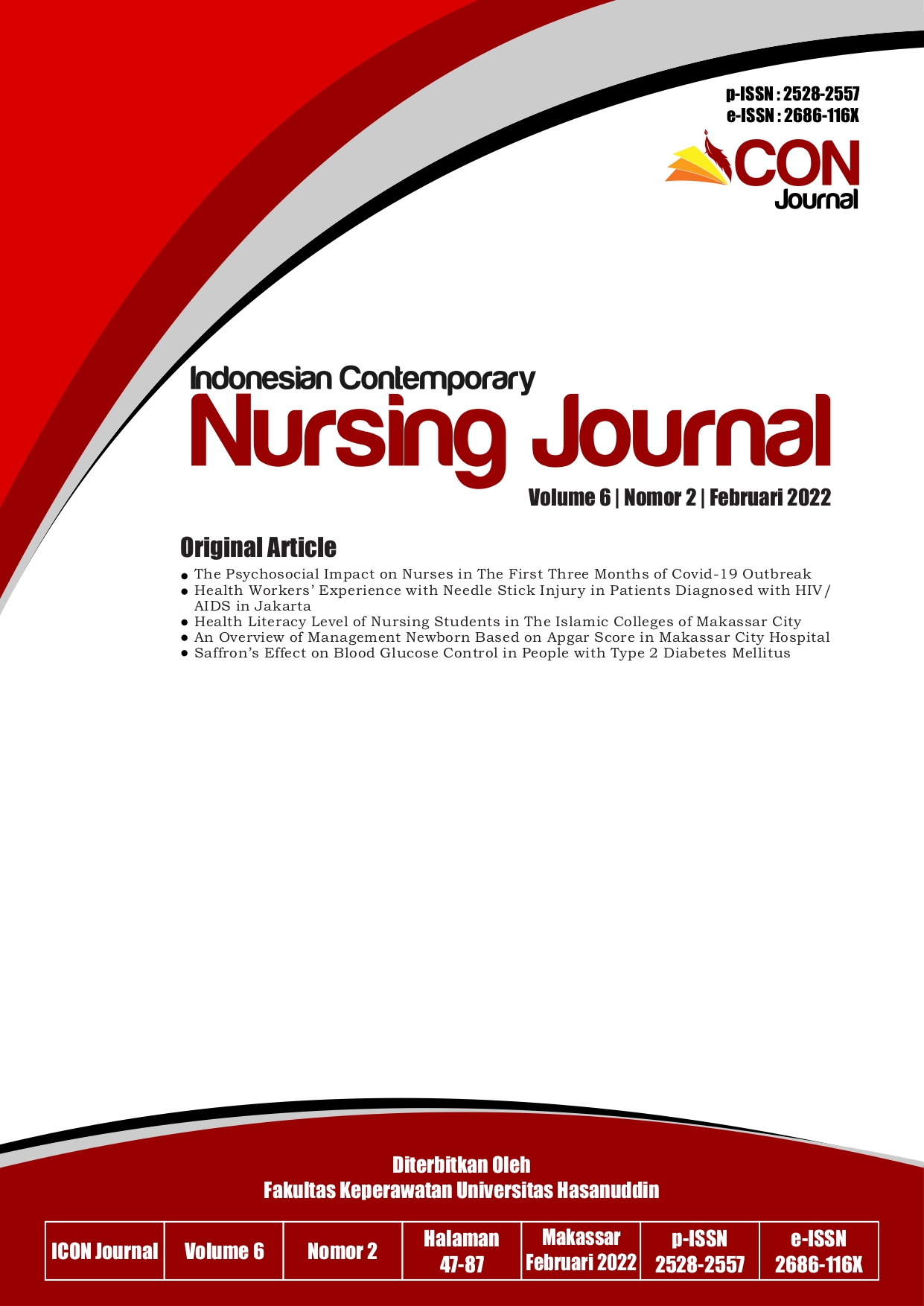Health Workers’ Experience with Needle Stick Injury in Patients Diagnosed with HIV /AIDS in Jakarta
DOI:
https://doi.org/10.20956/icon.v6i2.11091Keywords:
HIV/AIDS, Health Worker, Needle Stick InjuryAbstract
Introduction. HIV/AIDS is a virus that attacks the human immune system. In this case, experience refers to an event felt by a needle-injected healthcare workers with a diagnosis of HIV/ AIDS. Experience is an expression of expectation from healthcare workers to healthcare workers who have not experienced the incidence of needle injecting patients with a diagnosis of HIV/ AIDS. Health worker’s experience who had been pierced by a patient's needle (needle stick injury) would experience psychological effects such as anxiety, irritation, and guilty feelings. In this study, the participants, which are the healthcare workers, were expected to share information about their first experience when being injected with HIV/AIDS contaminated needle. This study aims to give a meaning in the experience of the healthcare workers who were injected with needle from patients with HIV/AIDS. Method. This study used qualitative method with a descriptive phenomenological approach by involving 5 participants, namely healthcare workers who had worked for more than 4 years. Result. The results were obtained by in-depth interviews and analyzed through the Collaizi method using the NVivo application. The results of the study found 3 (three) themes, the first theme is, Response and adaptation of needle injected HIV/ AIDS patients which generated several categories (psychological, spiritual and social responses) and (psychological, spiritual, and social adaptations). The second theme is the effect of having ARV therapy which causes both physical effects and psychological effects. The third theme is the precautionary measures of HIV/AIDS needle-injected, which consist of preventive and rehabilitative actions. Conclusion: Healthcare services have an obligation to provide support and motivation to healthcare workers who experienced the incidence of being injected by needle from patients with a diagnosis of HIV/AIDS
References
Amukugo, H. J., Shitokelwa, T. H., & Nuuyoma, V. (2018). Experiences of University of Namibia Africa Nursing on Needle Stick Injuries: A Qualitative Study. International Journal of Medical Science and Health Research, 02. Retrieved from www.ijmshr.com.
Centres for Disease Control and Prevention (CDC). (2014). About HIV/AIDS. From http://www.cdc.gov/hiv/basics/whatishiv.html
Ditjen P2P, Kemenkes RI. (2020, 09 November). Laporan Perkembangan HIV AIDS & Penyakit Menular Seksual (PIMS) Triwulan III Tanun 2020. Jakarta : Kementerian Kesehatan Republik Indonesia Direktorat Jendral Pencegahan dan Pengendalian Penyakit.
Erlina, R., Winarso, M. S., & Haryani, H. Gambaran Stress Kerja Perawat dalam Pelaksanaan Asuhan Keperawatan pasien HIV/AIDS. Jurnal Ilmu Keperawatan, 1(3), 153-159.
Hämäläinen, P .; Takala, J .; & Boon Kiat, T. (2017). Perkiraan Global Kecelakaan Kerja dan Penyakit yang Berhubungan dengan Kerja 2017. Kongres Dunia XXI tentang Keselamatan dan Kesehatan di Tempat Kerja. Singapura: Lembaga Keselamatan dan Kesehatan Kerja
Lara, K., Mardiah, W., & Priambodo, A. P. (2014). Pengetahuan, sikap, dan praktik kewaspadaan universal perawat terhadap penularan HIV/AIDS. Jurnal Ners, 9(1), 11-18.
International Labour Organization (ILO). (2018). Pelayanan Kesehatan dan HIV/AIDS. Organisasi Kesehatan Dunia. from www.ilo.org/publns
Ivana, A., Widjasena, B., & Jayanti, S. (2014). Analisa Komitmen Manajemen Rumah Sakit (RS) Terhadap Keselamatan Dan Kesehatan Kerja (K3) Pada RS Prima Medika Pemalang. Ejournal, Volume 1. Retrieved Agustus 08, 2018, from https://ejournal3.undip.ac.id/index.php/jkm/article/view/6372
Jeong, J. S., Son, H. M., Jeong, I. S., Son, J. S., Shin, K. S., Yoonchang, S. W., . . . Han, S. H. (2016). Qualitative content analysis of psychologic discomfort and coping process after needlestick injuries among health care workers. American JournalOf Infection Control. Retrieved from https://www.ajicjournal.org/article/S0196-6553(15)00975-X/fulltext
Katiandagho, D. (2017). Epidemiologi HIV-AIDS. Bogor : In Media.
KemenKes. (2017, November 13). Pedoman dan Standar Etik Penelitian dan Pengembangan Kesehatan Nasional. Retrieved Februari 19, 2021, from Komisi Etik Penelitian dan Pengembangan Kesehatan Nasional Kementerian Kesehatan Republik Indonesia: http://kepk.poltekkestasikmalaya.ac.id
Laras, A., & Resdasari, A. (2016). Copping Terhadap Stress kerja Perawat Yang Pernah Menangani Pasien HIV/AIDS. Jurnal Empati, 05. Retrieved 03 07, 2019
National Centre For Biotechnology Information (NBCI). (2018). Prevalence of occupational injuries and knowledge of availability and utilization of post exposure prophylaxis among health care workers in Singida District Council, Singida Region, Tanzania. Africa Journal US National Library of Medicine National Institutes of Health, from https://www.ncbi.nlm.nih.gov/pubmed/30359370
Puspasari, D., Wisaksana, R., & Ruslami, R. (2018). Gambaran Efek Samping dan Kepatuhan Terapi Antiretroviral pada Pasien HIV di Rumah Sakit Dr. Hasan Sadikin Bandung. JKS, 03
Sudiantara, P. H., & Somia, I. A. (2015). Karakteristik Pejanan Jarum Suntik Pada Tenaga Kesehatan di Ruah Sakit Sanglah Denpasar. Open Journal Systems, 04. Retrieved from https://ojs.unud.ac.id/index.php/eum/article/view/18097
UNAIDS (Joint United Nations Programme on HIV and AIDS). (2020). Retrieved Augustus 25, 2020, from Global HIV & AIDS statistics — 2020 fact sheet: https://www.unaids.org/en/resources/fact-sheet
Villarinhol, M. V., & Itayra , M. P. (2015). Post-accident work behavior in caring for people with HIV/Aids. Rev Bras Enferm. Retrieved from http://dx.doi.org/10.1590/0034-7167.2015680412i
Downloads
Published
How to Cite
Issue
Section
License
Authors who publish with this journal agree to the following terms:Authors retain copyright and grant the journal right of first publication with the work simultaneously licensed under a Creative Commons Attribution License that allows others to share the work with an acknowledgement of the work's authorship and initial publication in this journal.
Authors are able to enter into separate, additional contractual arrangements for the non-exclusive distribution of the journal's published version of the work (e.g., post it to an institutional repository or publish it in a book), with an acknowledgement of its initial publication in this journal.
Authors are permitted and encouraged to post their work online (e.g., in institutional repositories or on their website) prior to and during the submission process, as it can lead to productive exchanges, as well as earlier and greater citation of published work (See The Effect of Open Access).



